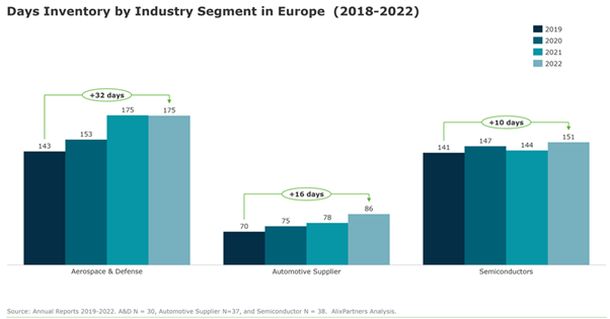- within Real Estate and Construction topic(s)
Inventory management is a critical aspect of supply chain management that has become an increasingly hot topic in recent years. Organizations are constantly looking for ways to optimize their inventory levels, whether it be to free up space, reduce lead times, or conserve cash. However, reducing inventory levels can be complex, especially in the context of a disrupted supply chain, as a consequence of the COVID-19 pandemic, economic downturns, or geopolitical conflicts like the Ukraine war. As a result, inventory levels have increased due to reduced outbound shipments, production challenges, larger buffer stock and accumulating available materials. In this article we share insights and lessons learned from Aerospace, Automotive, and Semiconductor Companies on Effective Inventory Management During Supply Chain Disruptions.

For key industry segments in Europe, the days inventory coverage increased over the last 4 years. In the aerospace and defense industry, for instance, days inventory increased from 143 in 2019 to 175 in 2022. The automotive supplier industry saw an increase from 70 in 2019 to 86 days in 2022, while the semiconductor industry experienced an increase from 141 to 151 days over the same period. These figures highlight the varying inventory management challenges faced by companies operating in different industries amidst supply chain disruptions seen the last few years.
Navigating Inventory Management Challenges in Disrupted Supply Chains
Effective inventory management is critical for raw materials, work in progress, and finished goods inventory. However, beyond simple inventory management principles, it is not easy to reduce inventories. Lot size or minimum order quantity (MOQ), lead time or cycle time, and safety stock targets can all be optimized. Still, inventories are often far above the targets set in the systems because disruptions are higher than the historical level, and safety parameters are not adapted, or additional buffers get built in.
Increasing homogeneously the safety parameters up to the disruption level implies unsustainable inventory levels, requiring taking risky decisions such as limiting supply to what can be produced or postponing the supply of confirmed orders, among others.
Despite these challenges, rigorous decision-making and execution can make a significant impact. Informed decision-making based on correcting myths about inventory reduction is one such approach. For example, inventory is the result of in-out, and the only way to reduce inventories when throughput is constrained is to reduce inflow. Available material is required to produce on-time in full (OTIF), but oversupply of what is available does not improve on-time delivery (OTD). It is essential to introduce adherence key performance indicators (KPIs) such as planning forecast accuracy and in/out ratio to help monitor inventory levels. By encouraging collaboration between stakeholders, organizations can develop more efficient supply chain processes, reduce lead times, and minimize excess inventory.
Lessons Learned from Aerospace, Automotive, and Semiconductor Companies on Effective Inventory Management During Supply Chain Disruptions
Several organizations we work with have successfully implemented inventory reduction strategies to optimize their supply chains and improve working capital in a disrupted supply chain in Europe. Following examples illustrate some of the key points.
- Aerospace industry:
- An aerostructure manufacturer reduced its inventory by 35 days in nine months by realigning production planning and capacity. This involved rescheduling 75% of purchase and work orders, monitoring planning adherence, and removing additional buffers introduced over time by various stakeholders.
- Another aerospace parts manufacturer reduced its work-in-progress inventory by 15% in six months. They limited production launches, increased internal/external production capacity by qualifying subcontractors and improving OEE, reduced batch sizes, and prioritized non-conformity treatment.
These examples show that a combination of different tactics, such as limiting production launches and increasing production capacity, can be successful in reducing inventory.
- Auto-parts suppliers:
- Automotive suppliers reduced their inventory by 25-30% within 4-6 months.
- The programs include optimizing planning parameters and specifications, adjusting order and production lot sizes, cleaning up overstock/obsolete and quarantine stock, transparency in stock development, and optimizing transport routes and unloading points.
- In addition, the focus is put on asset de-bottlenecking through a combination of process, technical, and organizational measures, along with rigorous monitoring of Overall Equipment Effectiveness (OEE).
- Safety stock re-allocation required a coordinated approach, considering shortage risk and overall production impacts across materials disposition teams in the supply chain.
- Tactical and operational-level workforce management enabled lot size smoothing and improved synchronization across production areas.
- Improved planning of production start/stops, forecasting quality, and spare parts management contributed to inventory reduction.
These examples show that a combination of informed decision-making based on correcting myths and informed risk-taking decisions such as limiting supply to what can be produced are successful in balancing and reducing inventory within disrupted supply chains.
- Semiconductor manufacturer:
- A leading semiconductor manufacturer implemented a differentiated supply chain, reduced manufacturing and distribution complexity, and transitioned from a push to a pull system.
- By modeling individual supply chain and manufacturing scenarios and fine-tuning supplier management processes, the company achieved a 30% reduction in inventory.
- The company saw a 20% reduction in network complexity, a 28%-45% improvement in transit times, and a 20%-30% reduction in cycle time.
This example shows that a differentiated supply chain, pull system and complexity reduction in manufacturing / distribution are key to build in resilience and keep inventories low in turbulent times.
In conclusion, reducing inventory levels in a disrupted supply chain can be a daunting task, but with rigorous decision-making, informed leadership involvement, and multifunctional alignment, significant reductions in inventory levels can be achieved within a short period. By correcting myths about inventory reduction and optimizing planning parameters and specifications, organizations can reduce inventory while maintaining or improving service levels. The examples from A&D, automotive supplier, and semiconductor industries show that a combination of different tactics, such as limiting production launches, increasing production capacity, planning forecast accuracy, in/out ratio, safety-stock rebalancing, adherence KPIs, complexity reduction and a differentiated supply chain companies can better manage their inventory levels and improve their overall supply chain performance despite facing globally disrupted supply chains.
The content of this article is intended to provide a general guide to the subject matter. Specialist advice should be sought about your specific circumstances.



